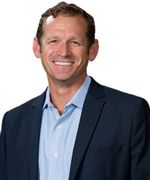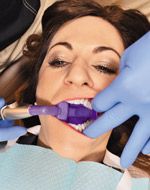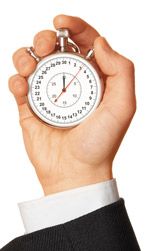How to work more efficiently, create extra time
Time is the slippery demon in our practices. Sometimes we have extra time, but, mostly, we do not have enough time. Most certainly, if we had more of it, we could do more, see more, produce more, serve more people or take that time to do other things. Andrew By increasing efficiency in our practices, we can make our productive time even more productive; something I call productive productivity.

Time is the slippery demon in our practices. Sometimes we have extra time, but, mostly, we do not have enough time. Most certainly, if we had more of it, we could do more, see more, produce more, serve more people or take that time to do other things.

By increasing efficiency in our practices, we can make our productive time even more productive; something I call productive productivity. In an attempt to find ways to increase productive productivity in our practices, we look for new techniques, methodologies and products that help us to run more efficiently. I recently ran a study utilizing mr. thirsty® one-step to see if this product could indeed help us operate more efficiently.
A few years ago, I volunteered at a children’s cancer unit. I became affectionately known as the tooth ferry guy. Yes, tooth ferry, because I would bring little wooden boats to the kids for them to paint. We would craft the boats and design custom paint jobs then use whatever we could find in the drawers of their hospital room to decorate them.
When we were finished with the boats, I would adorn the sail with a small white tooth. One of the kids I spent time with was Alex. Alex had leukemia and was in the hospital for his third bone marrow transplant. He was a fighter, and I left his room many times in tears at his resiliency and will to live life to its fullest.
In the time I spent with Alex, one of his parents was always nearby, but they usually did not interrupt and allowed us to have our time. Alex’s parents were strong, too, and I never saw them show signs of weakness until one day in the cafeteria. On my way out of the hospital, running back to my office to see patients, I ran through the cafeteria to grab a sandwich and saw Alex’s father alone and crying. Awkwardly, I went over to say hi, and he offered me a seat.
He explained to me that they were always positive around Alex, but they were afraid this final attempt to cure the cancer would not work. He said the experience of being at the hospital and all the strangers who came to support Alex was amazing. What pushed him over the edge on this particular day was when the people from Make-A-Wish Foundation came to see him because his only wish was that he had more time with his son.
Continue to Page 2 to read more ...

Time can be special
It takes time to build a practice, it takes time to build trust, it takes time to develop character and it takes time to foster relationships. Time is, unquestionably, our most precious commodity. If we only had more time. As business owners we want more time and more money.
How we get there is sometimes a mystery. Dental offices today run much more efficiently than they did 20 years ago, but can they be more efficient? And when they are more efficient, what do we do with the time?
Efficiency is key
After working as the chief dental officer with Smile Source, the leading dental alliance with more than 300 dental practices, I can say a vast majority of dental practices run inefficiently. Dentistry can learn from other industries to maximize efficiency in the dental office and, therefore, increase productive productivity.
Inefficiencies in dental practices often go largely unnoticed because there are a wide range of procedures and relatively decent profit margins providing resources that can cover up those inefficiencies. In an effort to test and prove ways to increase productivity and increase efficiencies, I recently found a product that can be a game changer.
In general, we dentists like to think of ourselves as good business people, and we remain one of the highest-paid professions with businesses that run healthy profit margins. From a business perspective, our businesses run themselves as long as we continue to provide the best care possible to our patients with consistently good outcomes. But, for most of us, we know we could spend more time working on our businesses instead of just in our businesses.
In the book “The e-Myth Revisited,” Michael Gerber says executives often get consumed with doing the work rather than building a business that can get the work done. This can be very challenging as a dentist because so much of what we do is who we are. When I talk to other friends, they often tell me they cannot afford to spend more time working on their business or they simply state that their business is running well.
The reality is a vast majority of dental practices are not well-run businesses. In fact, the way most doctors should respond is that they are making a good living, and they do not see the need to focus more on working on their businesses. Over the last three years, working with hundreds of practices, I found most doctors do not invest in their practices as if they were businesses. They overlook the need for the basic functions of business like marketing, strategic planing, analytics and accounting.
More on running a business: 4 ways to innovate your dental practice without breaking the bank
Continue reading on Page 3 ...

I was one of these dentists. I spent very little time working on the business simply because everything was going well. The danger is that eventually we would like to retire or sell our practices or be in a position to keep our practices late into our twilight years, and if we ARE the business, the business is nothing without you. Dentistry is one of the best businesses to be in, and if you have a well-run business, it’s possible to maintain it for many years. Efficiency in our practices is one of the first places to start.
Time and motion
Studying time and motion is obviously not a new idea. It was spawned during the Industrial Revolution and helped many industries be more productive. Time and motion studies offer a scientific approach to management to increase productivity. By breaking down procedures into small, repetitive motions and measuring the time it takes to perform those procedures, we can determine predictable productivity.
Furthermore, by evaluating the data from time-motion studies, we can identify and eliminate redundant or wasteful routines. For dentists, this could pay instant dividends. Evaluating time and motion can eliminate procedures, change times needed for procedures and substantially increase productivity.
More on time: Why now is the perfect time for your dental practice to examine its fees
An average eight-hour workday
is broken down into 480 minutes, and making each of those 480 minutes count is the key. So often dentists break down their procedures into 10- or 15-minute increments, but there is substantial benefit in first determining what the redundant and useless procedures are. Perhaps your goal is not to be more productive but better, or maybe your goal is to produce the same on less time. Regardless of your goal, you can benefit from becoming more efficient.
For many dentists, performing time and motion studies may not be necessary. Simply by supplementing techniques, utilizing technology or using new products, we often can improve our efficiency. When I was a new graduate, working with my new partner, I was amazed at how productive he could be. Not only did he outproduce me, he did great dentistry and also made a good living.
Over time, he learned how to be more efficient, profitable, consistent and productive. He mastered what I call productive productivity. While I was busy for the sake of being busy and “productive,” he was relaxed, producing quality dentistry and while being significantly more productive than I was. One of the biggest differences between us was efficiency. He was more efficient in his new patient exams and treatment planning. He was more efficient when preparing teeth for restorations, and he was more efficient with his procedures. One of the most valuable skills any dentist can learn is how to be efficient with both thoughts and motions.
A turning point for me was when I really learned how to utilize my assistant. I believe this is a challenge for employee-minded associates because utilizing an assistant is not just about somebody assisting the doctor; it’s about serving our patients and the practice.
More on time: How to make the most of your open time
Continue reading on Page 3 ...
Using mr. thirsty
Recently, I was working on the lower left quadrant preparing tooth Nos. 18, 19 and 20. In another chair, I had an emergency. As part of our procedure, I used the new mr. thirsty® one-step, which is a disposable, soft thermo-elastic elastomer mouth prop, isolation and suction device made by Zirc (zirc.com).
Utilizing mr. thirsty® one-step allowed me to work without my assistant while she screened the emergency patient, recemented a temporary crown and poured models. Our team was not just productive but efficient. I needed more proof that this product could actually help us to be more productive.
My study was simple. Like my great grandfather before me; I performed a time and motion study to compare the time for procedures not using mr. thirsty® one-step to those utilizing it. Procedures were standardized to be sure the same products and protocols were followed by the four doctors participating in the study.
I compared 10 of each of the following three procedures: a single two-surface filling, quadrant dentistry of three teeth with Class II restorations and crown preparations (for both CEREC® and digital impressions utilizing the 3M™ True Definition Scanner provided by Dental Services Group). I measured doctor time in the room, patient chair time, assistant time while the doctor was out of the room and total time the chair was unavailable (for cleaning, turnover and procedure time). We also measured the total time we ran behind schedule and the amount of time we were ahead of schedule.
More on efficiency: The efficiency of going paperless
My hypothesis was that mr. thirsty® one-step would improve our efficiency. I was surprised at just how much it really helped. Additionally, performing a time and motion study with our team highlighted other inefficiencies and areas of opportunity for us to improve.
In this study, I found that utilizing mr. thirsty® one-step decreased the doctor time across all procedures. Additionally, using mr. thirsty® one-step freed up assistants to either see other patients or perform other tasks. During crown procedures, we witnessed a 26-percent decrease in chairtime, allowing us to finish an average of 16 minutes ahead of schedule. For CEREC® crowns, we saw a 16-percent decrease in chairtime.
Surprisingly, all of our procedures had a total chairtime of less than an hour when utilizing mr. thirsty® one-step during the CEREC®. This was surprising because nine of the 10 CEREC procedures measured were scheduled for 80 or 90 minutes with an average of 81 minutes. This proved we could comfortably decrease the amount of time we schedule for CEREC procedures.
Video: Sirona unveils more details for CEREC 30 CAD/CAM celebration
Continue reading on Page 4 ...
Furthermore, assistants had less chairtime as well, and we also experienced greater ease with digital mr. thirsty® one-step. For Class II restorations, the improvement in time was 24 percent, adding an average of 8 minutes. The doctors and assistants both rated mr. thirsty® one-step highly during Class II restorations and, when operating on mandibular teeth, the doctor is able to work without an assistant, if necessary.
The most dramatic difference seen was with quadrant dentistry. It is well-known that performing quadrant dentistry is a more efficient use of time, which this study also highlighted, but when using mr. thirsty® one-step, we decreased our chairtime by 35 percent.
For the 10 procedures measured, a total of 249 minutes was added. This is significant considering an eight-hour day is 480 minutes. If you produce an average of $600 an hour, that’s an additional $2,400 of production added to your schedule. Greater efficiency leads to productive productivity, and mr. thirsty® one-step proved to be a tremendous asset to our practice.
The digital journey: Incorporating digital solutions into your practice
Remember Alex? He graduated from college and is married and still very much alive. Alex and his father spend every Sunday together. They have two rules; no electronic devices and the time together is nonnegotiable.
What will you do with the extra time?
To learn more about Zirc mr. thirsty, watch the video below:
About the author
Dr. Andrew M. Goldsmith, DDS, FIALD, DICOI, practices dentistry in Minneapolis and is the past chief dental officer and vice president of vendor relations for Smile Source, the leading alliance for independent practice dentists with more than 300 locations.